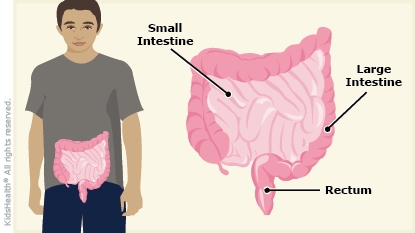Rectal Bleeding: How to Care for Your Child
Bleeding from the rectum can happen for different reasons. Diarrhea (watery poop) and constipation (hard poop) can irritate or stretch the lining of the rectum, causing scratches or tears. Polyps (small growths of tissue), sores, or hemorrhoids (swollen veins) in the rectum's lining can bleed. To look for the cause of bleeding, the doctor may do a colonoscopy. During this procedure, the doctor places a thin tube with a tiny camera attached into the rectum and colon to get a close look at the area.


-
If the health care provider ordered tests for your child, have them done as soon as possible. Follow up as instructed to get the test results.
-
Take note of the amount of rectal bleeding your child has. If there is a change, let your health care provider know.
-
Make changes in your child's diet if recommended.
-
If your child is having pain, acetaminophen (such as Tylenol® or a store brand) may help. Don't give ibuprofen while your child is having rectal bleeding unless your provider says it's OK.

Your child:
-
has belly pain
-
has a fever or chills
-
has sweating at night for no known reason
-
develops new problems such as a rash, joint pain, bleeding in other areas of the body, or weight loss
-
has new or worse constipation (fewer bowel movements or straining during bowel movements)
-
gets diarrhea again or has diarrhea that gets worse or doesn't get better in a week
-
has pain in the anus or rectum
-
is vomiting or can't drink liquids

Your child:
-
is passing larger amounts of blood
-
has blood coming from the rectum more often
-
has severe belly pain
-
is very sleepy or hard to console
-
is not urinating (peeing) or is peeing much less than usual
-
appears dehydrated; signs include dizziness, drowsiness, a dry or sticky mouth, sunken eyes, crying with few or no tears

What else can lead to rectal bleeding? Other things that can cause rectal bleeding include:
What are the signs of rectal bleeding? Signs that a child has rectal bleeding include blood in the toilet, on the poop, or on baby wipes or toilet paper when wiping after a bowel movement (BM). Sometimes kids have pain during and after BMs, but other times there is blood without any pain.
Can stool contain blood that doesn't come from the rectum? Blood in the stool can come from any part of the digestive tract, from the esophagus to the rectum and anus (where poop comes out). Blood that comes from lower down in the digestive tract (colon, rectum, or anus) is usually bright red or darker red in color. Blood that comes from higher up in the digestive tract (esophagus, stomach, or small intestine) will look much darker and sometimes even black. Sometimes, blood can come from swallowed blood if a child has had bleeding from the mouth, throat, or nose.